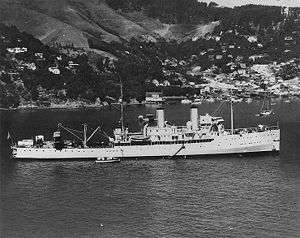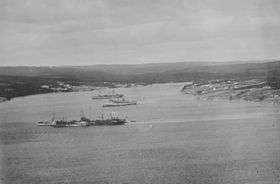USS Aroostook (CM-3)
 USS Aroostook in harbor | |
| History | |
|---|---|
| Name: | USS Aroostook |
| Cost: | $1,350,000 (hull and machinery)[1] |
| Launched: | 26 March 1907, as SS Bunker Hill |
| Acquired: | 12 November 1917 |
| Commissioned: | 7 December 1917 |
| Decommissioned: | 10 March 1931 |
| Renamed: | Aroostook, November 1917 |
| Reclassified: |
|
| Struck: | 5 February 1943 |
| Fate: | Sold for scrap in October 1947 |
| General characteristics | |
| Type: | Minelayer |
| Displacement: | 3,800 long tons (3,900 t) |
| Length: | 395 ft (120 m) |
| Beam: | 52 ft 2 in (15.90 m) |
| Draft: | 16 ft (4.9 m) |
| Speed: | 20 kn (23 mph; 37 km/h) |
| Complement: | 313 |
| Armament: | 1 × 5 in (130 mm)/51 cal gun, 2 × 3 in (76 mm)/50 cal dual purpose guns, 2 × .30 in (7.6 mm) Colt machine guns |
The USS Aroostook (ID-1256/CM-3/AK-44) was the Eastern Steamship Company's Bunker Hill converted for planting the World War I North Sea Mine Barrage. Bunker Hill was built in 1907 at Philadelphia, Pennsylvania for passenger service between Boston and New York City. Bunker Hill and her sister ship Massachusetts were among the eight ships acquired by the U.S. Navy in November 1917. The two coastal passenger steamers were converted to minelayers at the Boston Navy Yard.
World War I for the USS Aroostook - 1918
After a brief shakedown cruise in mid-June 1918, Aroostook took on board a load of mines and then began a voyage across the Atlantic Ocean in the company of her sister minelayer, the USS Shawmut. This voyage, aided by the novel technique of refueling at sea, took her to Scotland, where in July she participated in laying the North Sea Mine Barrage, laying thousands of mines across the mouth of the North Sea in order to create a barrier for German U-boats trying to depart from German seaports to the open Atlantic. Aroostooklaid a total of 3,180 mines in this operation:
- planted 320 mines during the 3rd minelaying excursion on 14 July,
- planted 320 mines during the 4th minelaying excursion on 29 July,
- planted 290 mines during the 5th minelaying excursion on 8 August,
- planted 330 mines during the 6th minelaying excursion on 18 August,
- planted 310 mines during the 7th minelaying excursion on 26 August,
- planted 290 mines on 30 August to complete the 7th minefield after USS Saranac was unable to lay its mines,
- planted 320 mines during the 9th minelaying excursion on 20 September,
- planted 330 mines during the 10th minelaying excursion on 27 September,
- planted 330 mines during the 11th minelaying excursion on 4 October, and
- planted 340 mines during the final 13th minelaying excursion on 24 October.[2]
This effort, nearly completed, was the major operation of the U.S. Navy in European waters during World War I, and it came to an end on 11 November 1918 with the Armistice with Germany and the end of fighting in World War I. The USS Aroostook steamed home to the East Coast in December 1918
An aircraft tender, 1919 - 31
During the spring of 1919, the USS Aroostook was refitted as an "aircraft tender" to support the attempt by U.S. Navy naval aviators to make the first transatlantic crossing of the Atlantic Ocean by air. The Navy had four huge Curtiss NC floatplanes built for the project. These aircraft were twice the size of contemporary aircraft. The route for this attempt used southeastern Newfoundland and the Portuguese Azores Islands as stopping-off points for refueling and maintenance work on the new planes, and for rest and mess periods for their aviators. In the event of the attempt, mechanical problems and lack of replacement parts necessitated the cannibalization of one of the aircraft, leaving three "Nancys" for the attempt.

During the first half of May, 1919, the Aroostook was waiting at the port of Trepassey, Newfoundland, to serve as a floating base for the three medium-sized Curtiss NC floatplanes that took off from the New York City area on the 16th. After taking care of the Curtiss NCs and their crews, and seeing them off towards the Azores, the Aroostook next steamed to England, where she rendezvoused with the NC-4, the only airplane to complete the transatlantic flight, at the end of May. The crewmen of the Aroostook then disassembled the NC-4 and loaded her onto the ship for the voyage back to United States.
In August and early September, the Aroostook carried a cargo of naval mines and supplies to California via the Panama Canal. She spent the rest of the year on the West Coast carrying out transportation missions and also as the aviation flagship for the Pacific Fleet.
Though she continued to be classified as a "minelayer", and she received the warship designation CM-3 (minelayer) in mid-1920, the Aroostook's remaining active service was as an aircraft tender. Throughout the 1920s, she mainly served on the Eastern Pacific Ocean, but she made occasional voyages to the Caribbean Sea and the Atlantic Seaboard to take part in the annual, massive "fleet problem" exercises.
The Aroostook also steamed to Hawaii and back in 1925 and 1928, including on the first occasion as the support aircraft tender for a pioneering attempt to fly two patrol planes from the West Coast to Hawaii.
Decommissioning and sale, 1931 - 47
Taken out of commission in March 1931 at the Puget Sound Navy Yard, Bremerton, Washington, the Aroostook was laid up on reserve for the entire next decade. With World War II raging in Europe, and the war threatening to spread worldwide soon, she was considered for reactivation as a cargo ship, and in May 1941, she was redesignated the AK-44. However, her age and her limited capabilities kept her inactive. In February 1943, the Aroostook was stricken from the Naval Vessel Register and then transferred to the War Shipping Administration. Regaining the name Bunker Hill, she stayed in port for the rest of the war. Although she was sold in 1947 to a firm that planned to use her as a floating casino, those plans fell through, and the old ship was next seized by the U.S. Government, which sold her for scrapping in October 1947.
References
- This article incorporates text from the public domain Dictionary of American Naval Fighting Ships. The entry can be found here.
- ↑ "Table 21 - Ships on Navy List June 30, 1919". Congressional Serial Set. U.S. Government Printing Office: 762. 1921.
- ↑ Belknap, Reginald Rowan The Yankee mining squadron; or, Laying the North Sea mining barrage (1920) United States Naval Institute p.110
External links
- USS Aroostook : Naval Historical Center
- Photo gallery of USS Aroostook at NavSource Naval History